Introduction
It is generally thought that as diets are ground to a smaller mean particle size, a linear improvement in nutrient utilization and pig performance will be observed. Research has demonstrated this benefit when particle size is reduced from 1,000 microns to approximately 600 microns. However, further reduction of particle size below 600 microns has not shown consistent benefits when fed to nursery pigs and has been reported to reduce feed intake and gain in finishing pigs. Generally, as grains are ground to a small mean particle size, the resulting increase in the amount of very fine particles has been shown to affect the diets’ palatability. The two primary manufacturing processes by which corn is ground include using a hammer or roller mill. Hammermilling benefits include the ability to grind a wide variety of ingredients to a very small particle size. A major disadvantage of using a hammermill is the increase in variation, as compared to that of roller mill-ground grain. The roller mill can grind grain to a much more consistent particle size with reduced operating costs, as compared to a hammermill. Previously, roller mill manufacturing technology did not allow the mean particle size to be reduced as fine as that of a hammermill. Recent advances in feed manufacturing technology allow producers to grind to a much finer particle size, using three or four sets of grinding rolls, while maintaining a consistent mean particle size and minimizing the amount of very fine particles. The objective of this series of experiments was to compare feed from various roller mill configurations on feed preference and performance of nursery pigs.
Procedures
The Kansas State University Institutional Animal Care and Use Committee approved the protocols used in these experiments. The studies were conducted at the K-State Swine Teaching and Research Center and Segregated Early Weaning Facility in Manhattan, KS.
A total of 410 pigs were used in two experiments. In all experiments, pigs were randomly allotted to pens based on initial pig weight following weaning and were fed a common diet until reaching approximately 25 lb. All corn used in experimental diets was ground at a commercial feedmill (New Fashion Pork, Estherville, Iowa) using a 4-high roller mill (RMS Roller-Grinder, Harrisburg, SD) and subsequently transported to the O. H. Kruse Feed Technology Center at Kansas State University for manufacture of the complete diets. For treatments 1 and 2, corn was ground using two or three sets of rolls, respectively, and lower rolls were fully opened during processing to allow the ground grain to pass without any further particle size reduction. The roller mill configurations for each treatment were: (1) 2 sets of grinding rolls with roll gaps open to 0.035 and 0.025 in. (2-high); (2) 3 sets of grinding rolls with roll gaps open to 0.035, 0.025, and 0.020 in. (3-high); (3) 4 sets of grinding rolls with gaps open to 0.035, 0.025, 0.015, and 0.009 in. (4-high fine); and (4) 4 sets of grinding rolls with roll gaps open to 0.040, 0.030, 0.030, and 0.025 in. (4-high coarse). All grinding rolls had a 2% left spiral. The number of corrugations per inch increased with each set of rolls. The top rolls each had 6 corrugations per inch. The second set had 10 corrugations per inch. The third set had 1 roll with 12 and a second roll with 14 corrugations per inch. The fourth set of rolls had 1 roll with 14 and 1 roll with 16 corrugations per inch. Roll speed was offset and was 1,126 rpm for the fast roll (16.0-in. diameter sheave) and 763 rpm for the slow roll (23.6-in. diameter sheave). Corn feed rate was set based on a targeted 85% load on the roller mill. Roller mill performance data were collected during processing and included electricity consumption, grinding rate, and physical analysis of the grain as it progressed through the grinding rolls. These results are detailed in Gebhardt et al., 2015.
In Exp. 1, pens of pigs (320 DNA 400 × 200, initially 23.6 lb) were randomly allotted to 1 of 4 dietary treatments and fed for 21 d, with 16 pens per treatment and 5 pigs per pen. The 4 dietary treatments used the identical corn-soybean meal-based formulation that was manufactured from the same batch of ingredients (Table 1). Experimental diets were: (1) feed with the corn fraction ground to 650 µm using 2 sets of rolls, (2) feed with corn fraction ground to 495 µm using 3 sets of rolls, (3) feed with corn fraction ground to 340 µm using 4 sets of rolls in a fine-grind configuration, and (4) feed with the corn fraction ground to 490 µm using 4 sets of rolls in a coarse-grind configuration. Each pen contained a 4-hole, dry self-feeder and a nipple waterer to provide ad libitum access to feed and water. Pens had tri-bar floors and allowed approximately 2.7 ft2 /pig. Pig weights and feed disappearance were measured on d 0, 7, 14, and 21 to determine ADG, ADFI, and F/G.
Caloric feed efficiency was determined on both an ME and NE basis (NRC, 2012) and calculated by multiplying total feed intake × energy content of the diet (kcal/lb) and dividing by total gain. Feed cost/pig, feed cost/lb gain, revenue per pig, and IOFC were calculated to determine economic implications. Diet costs were determined using the following ingredient and processing costs: corn = $3.75/bu, soybean meal = $286/ton, base grind/mix/delivery fee = $12.00/ton, supplemental grinding electricity based on roller mill configuration per ton of ground corn = 2-high ($0.00/ton), 3-high ($0.175/ ton), 4-high fine ($0.645/ton), 4-high coarse ($0.246/ton). Costs were derived from collection of electricity consumption and grinding rate performance data for the roller mill, which resulted in the 2-high configuration having the lowest electricity cost/ton ground corn. The supplemental grinding electricity cost was drawn from the average additional electricity cost above the 2-high baseline cost of $0.3663/ton of ground corn, which was added to the grind/mix/delivery fee. Feed cost/pig was determined by total feed intake × diet cost ($/lb). Feed cost/lb gain was calculated using feed cost/pig divided by total gain. Revenue/pig was determined by total gain × $0.60/lb live gain, and IOFC was calculated using revenue/pig – feed cost/pig.
In Exp. 2, 90 pigs (PIC 327 × 1050, initially 27.0 lb) were randomly allotted to 1 of 3 dietary treatments with 6 pens per treatment and 5 pigs per pen. Experimental diets were fed for 7 d. Diets from treatments 1, 3, and 4 from Exp. 1 were used to determine the effect of grinding on feed preference. Each pen contained either two, 2-hole, dry self-feeders or two, 4-hole, dry self-feeders balanced among comparisons as well as a nipple waterer to provide ad libitum access to feed and water. Thus, the preference between 2 of the 3 diets could be tested within each pen. Feeders were rotated daily within each pen for the 7-d study. The 3 diet comparisons tested were 2-high vs. 4-high fine (1 vs. 3), 2-high vs. 4-high coarse (1 vs. 4), and 4-high fine vs. 4-high coarse (3 vs. 4). Pens had wire-mesh floors and allowed approximately 3.6 ft2 /pig. Feeders were weighed on d 0, 2, 4, and 7, and pig weights were collected on d 0 and 7 of the trial to determine ADG, ADFI, and F/G.
Complete diet samples were collected from feeders within treatment at multiple locations within feeder, subsampled, and submitted to Ward Laboratories, Inc. (Kearney, NE) for analysis of DM, CP, ADF, crude fiber, NFE, Ca, P, ether extract, ash, and starch. Particle size analysis was performed on all ground corn samples, and bulk density, angle of repose, and flowability index were determined at the Kansas State University Swine Lab. In addition, bulk density, angle of repose, and flowability index were determined for complete diets. Flowability was measured using a Flowdex device (Hanson Research, Chatsworth, CA), which measures flowability based on an ingredient’s ability to fall freely through a hole in the center of a disk. The flowability index is given as the hole diameter, expressed in millimeters, of the smallest hole disk 50 grams of an ingredient falls through freely on three consecutive attempts. Additionally, flowability was measured using angle of repose in which grain was placed in a cylinder on top of an 8.7 cm diameter pedestal. The cylinder was then lifted, which allowed the excess grain to fall freely. The height of the remaining grain was measured and used to calculate angle of repose. Particle size analysis was performed on all corn samples with and without a flow agent (Gilson Company, Inc., Lewis Center, OH) on a 13-sieve stack and pan, in the K-State Swine Lab on a Ro-Tap (W.S. Tyler, Mentor, OH) shaker for 15 minutes.
Data were analyzed as a completely randomized design using PROC GLIMMIX in SAS (SAS Institute, Inc., Cary, NC) with pen as the experimental unit for Exp. 1. For Exp. 2, feeder within pen was the experimental unit, and pen was included in the model as a random effect. The LSMEANS procedure of SAS was used to evaluate pen means (Exp. 1) and within pen mean difference in ADFI and was expressed as percentage of the total consumed for each diet (Exp. 2). Results were considered significant at P ≤ 0.05 and a trend at P ≤ 0.10.
Results and Discussion
As expected, chemical analysis of complete diets from both trials revealed no notable differences between treatments within experiment (Table 2). Corn ground using the 2-high configuration had the largest particle size and standard deviation (Table 3). Corn ground using the 3-high configuration and the 4-high coarse configuration had similar mean particle size, however the 3-high mill produced ground corn with a lower standard deviation. The 4-high fine configuration produced the finest particle size corn, as expected, and also had the lowest standard deviation. As particle size was reduced, surface area, expressed as cm2 /gram, increased.
Flowability using the Flowdex device resulted in similar flowability index scores for both 4-high configurations, whereas the 2-high configuration had an improved flowability index score, and the 3-high configuration had the most desirable flowability score (Table 3). The 4-high fine configuration had the least desirable angle of repose flowability score, whereas the 2- and 3-high configurations produced the most desirable ground corn based on angle of repose flowability. As expected, the corn produced from the 4-high fine configuration had the lightest bulk density, whereas the 2-high and 4-high coarse configurations ground corn had the heaviest bulk density.
Complete diets for Exp. 1 had similar Flowdex flowability scores for the 2-, 3-, and 4-high coarse configurations, whereas the 4-high fine configuration has the least desirable flowability score (Table 4). In Exp. 2, the 2-high configuration resulted in the lowest Flowdex flowability score, followed by the 4-high coarse configuration, and the 4-high fine configuration resulted in the least desirable flowability score. Angle of repose flowability resulted in similar results with the 2-high configuration having the most desirable flowability, and the 4-high fine configuration resulting in the least desirable flowability. As expected, complete diet bulk density was lightest for the 4-high fine configuration, and heaviest for the 2-high configuration.
In Exp. 1, there were no differences (P > 0.05) in ADG, ADFI, or F/G between roller mill configurations (Table 5). There also were no observed differences (P > 0.05) in caloric efficiency or economics among roller mill configurations.
In Exp. 2, pigs consumed more (67%; P < 0.05) of the diet containing 2-high roller mill manufactured corn than the diet with 4-high fine corn (33%; Table 6). There was no difference (P > 0.05) in feed consumption between the diet containing 2-high roller mill manufactured corn and the diet manufactured with corn from the 4-high roller mill in a coarse configuration (50.3 vs 49.7%, respectively). Pigs consumed more (63%; P < 0.05) of the diet manufactured using corn from the 4-high roller mill in a coarse configuration than the diet using corn from the 4-high mill in a fine grind configuration (37%).
In summary, nursery pigs preferred diets containing corn ground to 650 µm compared to diets containing corn ground to 340 µm, and preferred diets containing corn ground to 490 µm compared to diets containing corn ground to 340 µm. However, there was no observed difference in feed preference when pigs had access to diets containing corn ground to 650 µm (2-high) compared to 490 µm (4-high coarse). Roller mill ground corn did not show an improvement in growth performance below a particle size of 650 µm in nursery pigs. A 4-high roller mill has the capability to produce a finer grind and reduce particle size below the level possible with previous roller mills and similar to a hammermill; however, our study did not indicate a benefit in nursery pig performance or economic return when particle size was reduced below 650 µm.
Table 1. Diet composition for Exp. 1 and 2 (as-fed basis)1
Table 2. Chemical analysis of diets (as-fed basis)1
Table 3. Physical analysis of ground corn, Exp. 1 and 21
Table 4. Physical analysis of diets, Exp. 1 and 21
Table 5. Effects of roller mill configuration on growth performance in nursery pigs, Exp. 11
Table 6. Effects of roller mill configuration on feed intake preference in nursery pigs, Exp. 21,2,3
This article was originally published in Kansas Agricultural Experiment Station Research Reports: Vol. 1: Iss. 7. https://doi.org/ 10.4148/2378-5977.1119. This is an Open Access article licensed under a Creative Commons Attribution 4.0 License.
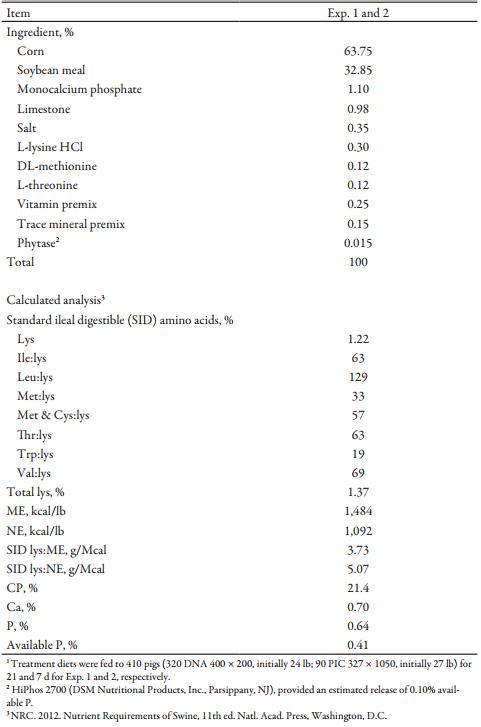
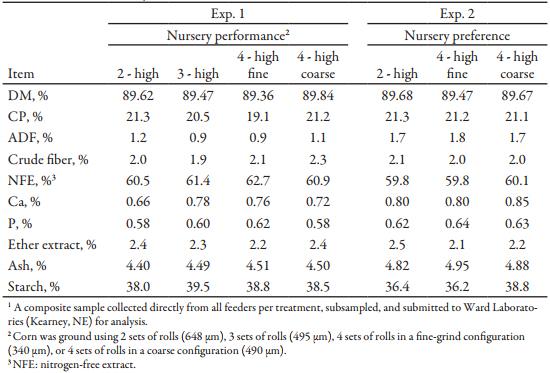

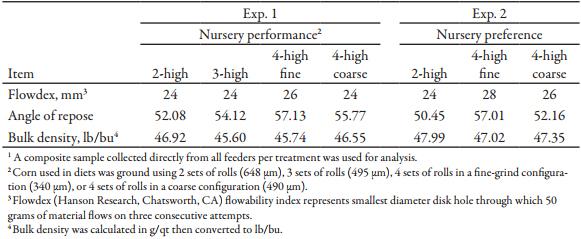
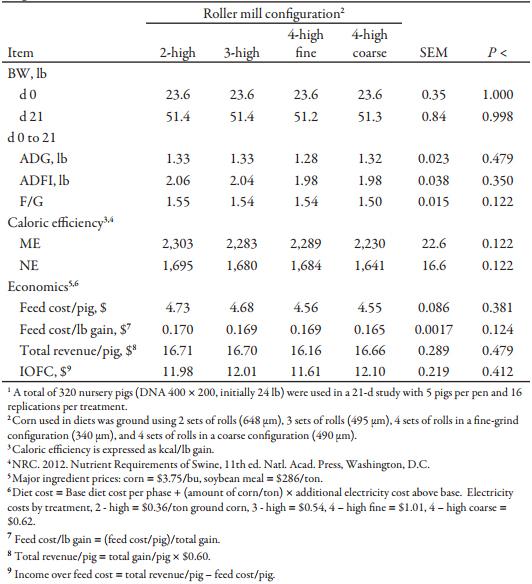
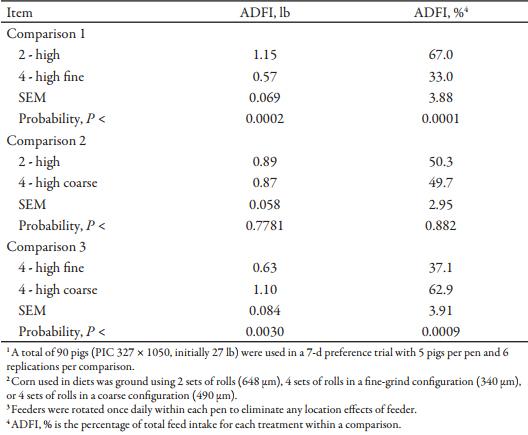











.jpg&w=3840&q=75)